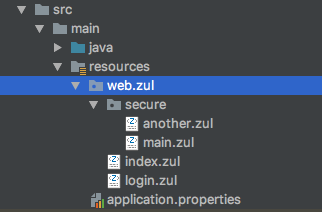Secure a ZK Application with Spring Security
Secure Your Application in Spring’s Way
Spring Security is a widely-adopted framework. It can also work with ZK without problems. This doesn’t even need zkspring-security. This page will show you how to do it. We assume you know the basics of Spring Boot and Spring Security. (You can read a Spring Security guide: Securing a Web Application ) So here we just mention those configurations specific to ZK framework.
The example code mentioned here only works for Spring Security 4/5.
ZK Spring Boot Starter
Spring encourages users to start with Spring Boot. So Please include zk spring boot starter, and it will automatically configure for you with most commonly-used settings.
Spring Boot Starter Security
Follow Securing a Web Application, we add the following elements:
<dependency>
<groupId>org.springframework.boot</groupId>
<artifactId>spring-boot-starter-security</artifactId>
<version>${springboot.version}</version>
</dependency>
Spring Controller
For simplicity, we just register 2 URL mappings:
/login: login page/secure/{page}: all secure pages
@SpringBootApplication
@Controller
public class Application {
public static void main(String[] args) throws Throwable {
SpringApplication.run(Application.class, args);
}
@GetMapping("/login")
public String login() {
return "login";
}
@GetMapping("/secure/{page}")
public String secure(@PathVariable String page) {
return "secure/" + page;
}
}
Then put the corresponding zul under web/zul folder.

Web Security Configuration
@Configuration
@EnableWebSecurity
public class WebSecurityConfig extends WebSecurityConfigurerAdapter {
public static final String ZUL_FILES = "/zkau/web/**/*.zul";
public static final String[] ZK_RESOURCES = {"/zkau/web/**/js/**", "/zkau/web/**/zul/css/**", "/zkau/web/**/img/**"};
// allow desktop cleanup after logout or when reloading login page
public static final String REMOVE_DESKTOP_REGEX = "/zkau\\?dtid=.*&cmd_0=rmDesktop&.*";
@Override
protected void configure(HttpSecurity http) throws Exception {
http.csrf().disable();
http.authorizeRequests()
.antMatchers(ZUL_FILES).denyAll() // block direct access to zul files
.antMatchers(HttpMethod.GET, ZK_RESOURCES).permitAll() // allow zk resources
.regexMatchers(HttpMethod.GET, REMOVE_DESKTOP_REGEX).permitAll() // allow desktop cleanup
.requestMatchers(req -> "rmDesktop".equals(req.getParameter("cmd_0"))).permitAll() // allow desktop cleanup from ZATS
.mvcMatchers("/","/login","/logout").permitAll()
.mvcMatchers("/secure/**").hasRole("USER")
.anyRequest().authenticated()
.and()
.formLogin()
.loginPage("/login").defaultSuccessUrl("/secure/main")
.and()
.logout().logoutUrl("/logout").logoutSuccessUrl("/");
}
@Bean
@Override
public UserDetailsService userDetailsService() {
UserDetails user =
User.withDefaultPasswordEncoder()
.username("user")
.password("password")
.roles("USER")
.build();
return new InMemoryUserDetailsManager(user);
}
}
- Line 7: We need to disable spring CSRF to make ZK AU pass security filter. But don’t worry. ZK already has its own CSRF mechanism.
- Line 13: This line blocks the public access to ZK class path web resource folder.
- Line 18-19: Assume we want all pages under
/secureare protected and require an authentication.
Login Page
No matter how you design a login page, remember to enclose it with a `